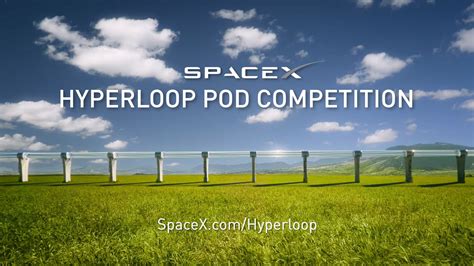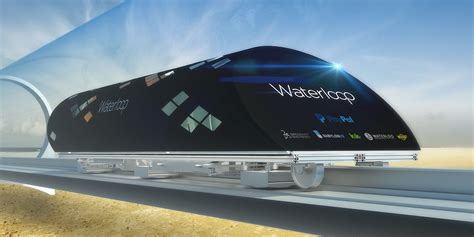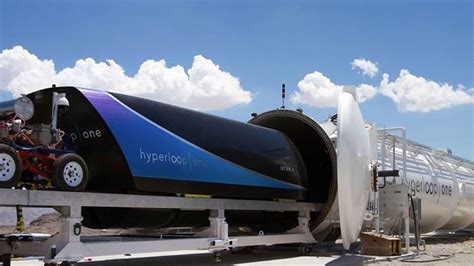Introduction to the Hyperloop Pod Competition
The Hyperloop Pod Competition, sponsored by SpaceX, has been a driving force in the development of high-speed transportation technology. The competition challenges teams from around the world to design, build, and test hyperloop pods capable of achieving incredible speeds within a vacuum tube environment. The ultimate goal is to revolutionize transportation by creating a system that can move people and goods at near-supersonic speeds, with minimal energy consumption and environmental impact.
History of the Hyperloop Concept
The hyperloop concept was first introduced by Elon Musk, the founder and CEO of SpaceX and Tesla, in a white paper published in 2013. Musk envisioned a transportation system that would use magnetic levitation and linear electric motors to propel passenger pods through low-pressure tubes at speeds of up to 760 mph (1,220 km/h). The system would be powered by renewable energy sources, such as solar panels, and would have a much smaller environmental footprint than traditional modes of transportation, such as cars and planes.
SpaceX’s Involvement in the Hyperloop Development
While Musk initially had no plans to develop the hyperloop technology himself, he decided to encourage others to take on the challenge by creating the Hyperloop Pod Competition. SpaceX has hosted the competition annually since 2015, providing teams with a 1-mile (1.6-km) test track and technical support to help them develop their pods. The competition has attracted teams from universities, startups, and established companies from around the world, all eager to showcase their innovative designs and push the boundaries of transportation technology.
The Winning Pod: TUM Hyperloop
In the 2019 Hyperloop Pod Competition, the team from the Technical University of Munich (TUM) emerged victorious with their pod, named the TUM Hyperloop. The TUM Hyperloop pod achieved a top speed of 463 km/h (288 mph), setting a new record for the competition and solidifying the team’s position as a leader in the field of hyperloop technology.
Team Background and Previous Achievements
The TUM Hyperloop team is composed of over 50 students from various disciplines, including engineering, computer science, and business. The team has been participating in the Hyperloop Pod Competition since its inception, consistently placing among the top contenders. In the 2018 competition, the TUM Hyperloop team won the award for the fastest pod, achieving a speed of 457 km/h (284 mph). The team’s success can be attributed to their innovative design approach, which focuses on lightweight materials, efficient propulsion systems, and advanced control algorithms.
Key Features of the Winning Pod
The TUM Hyperloop pod features several key innovations that set it apart from its competitors:
-
Lightweight Carbon Fiber Structure: The pod’s chassis is made entirely of carbon fiber, which provides exceptional strength and stiffness while keeping the weight to a minimum. This allows the pod to accelerate and decelerate quickly, and reduces the amount of energy required to maintain high speeds.
-
Linear Induction Motors: The pod uses linear induction motors for propulsion, which provide a high level of efficiency and reliability. The motors are controlled by advanced power electronics, which allow for precise control over the pod’s speed and acceleration.
-
Magnetic Levitation: The pod uses a passive magnetic levitation system, which eliminates the need for complex control systems and reduces the risk of mechanical failure. The levitation system is based on permanent magnets arranged in a Halbach array, which provides a strong, stable magnetic field that lifts the pod off the track.
-
Regenerative Braking: The pod is equipped with a regenerative braking system, which captures the kinetic energy generated during deceleration and converts it back into electrical energy. This helps to reduce the pod’s energy consumption and extends the range of the hyperloop system.
Implications for the Future of Transportation
The success of the TUM Hyperloop team has significant implications for the future of transportation. By demonstrating the feasibility of high-speed, energy-efficient transportation in a vacuum tube environment, the team has paved the way for the development of commercial hyperloop systems that could revolutionize the way we travel and transport goods.
Some potential benefits of hyperloop technology include:
- Reduced travel times between cities
- Lower energy consumption and environmental impact compared to traditional modes of transportation
- Increased capacity and efficiency of transportation networks
- Enhanced safety and reliability due to the controlled environment of the vacuum tube
However, there are also several challenges that must be addressed before hyperloop technology can be widely adopted, such as:
- High initial construction costs
- Regulatory and legal hurdles related to land use and right-of-way
- Technical challenges related to maintaining a stable vacuum environment over long distances
- Ensuring passenger comfort and safety at high speeds
Despite these challenges, the success of the TUM Hyperloop team and other participants in the Hyperloop Pod Competition has generated significant interest and investment in the development of hyperloop technology. Companies such as Virgin Hyperloop One, Hyperloop Transportation Technologies, and TransPod are actively working on developing commercial hyperloop systems, with the goal of having operational routes in place by the mid-2020s.

Frequently Asked Questions (FAQ)
-
What is the Hyperloop Pod Competition?
The Hyperloop Pod Competition is an annual event sponsored by SpaceX, in which teams from around the world design, build, and test hyperloop pods on a 1-mile test track. The goal of the competition is to encourage the development of high-speed, energy-efficient transportation technology. -
Who won the 2019 Hyperloop Pod Competition?
The team from the Technical University of Munich (TUM) won the 2019 Hyperloop Pod Competition with their pod, named the TUM Hyperloop. The pod achieved a top speed of 463 km/h (288 mph), setting a new record for the competition. -
What are the key features of the TUM Hyperloop pod?
The TUM Hyperloop pod features a lightweight carbon fiber structure, linear induction motors for propulsion, a passive magnetic levitation system, and regenerative braking. These innovations help to reduce the pod’s weight, energy consumption, and complexity, while enhancing its performance and reliability. -
What are the potential benefits of hyperloop technology?
Hyperloop technology has the potential to revolutionize transportation by providing high-speed, energy-efficient, and environmentally friendly travel between cities. It could reduce travel times, lower energy consumption and emissions, increase transportation capacity and efficiency, and enhance safety and reliability. -
What challenges must be addressed before hyperloop technology can be widely adopted?
Some of the key challenges facing the development and adoption of hyperloop technology include high initial construction costs, regulatory and legal hurdles related to land use and right-of-way, technical challenges related to maintaining a stable vacuum environment over long distances, and ensuring passenger comfort and safety at high speeds. Despite these challenges, significant progress is being made in the development of commercial hyperloop systems, with the goal of having operational routes in place by the mid-2020s.

Conclusion
The success of the TUM Hyperloop team in the 2019 Hyperloop Pod Competition represents a major milestone in the development of high-speed transportation technology. By achieving a record-breaking speed of 463 km/h, the team has demonstrated the feasibility of hyperloop technology and paved the way for the development of commercial hyperloop systems that could revolutionize the way we travel and transport goods.
While there are still significant challenges that must be addressed before hyperloop technology can be widely adopted, the progress made by teams like TUM Hyperloop and companies like Virgin Hyperloop One and Hyperloop Transportation Technologies is encouraging. With continued investment and innovation, it is possible that we could see operational hyperloop routes in place within the next decade, ushering in a new era of fast, efficient, and sustainable transportation.
| Year | Winning Team | Top Speed (km/h) |
|---|---|---|
| 2015 | No winner (design competition) | N/A |
| 2016 | No winner (competition canceled) | N/A |
| 2017 | Warr Hyperloop (Germany) | 324 |
| 2018 | WARR Hyperloop (Germany) | 457 |
| 2019 | TUM Hyperloop (Germany) | 463 |
Table 1: Winners of the SpaceX Hyperloop Pod Competition by year, with top speeds achieved.
As the table above shows, the top speeds achieved by the winning teams in the Hyperloop Pod Competition have steadily increased over the years, with the TUM Hyperloop team setting a new record in 2019. This progress is a testament to the hard work and dedication of the teams involved, as well as the potential of hyperloop technology to transform the transportation landscape.
In conclusion, the TUM Hyperloop team’s victory in the 2019 Hyperloop Pod Competition is a significant achievement that has captured the attention of the world. It represents a major step forward in the development of high-speed, sustainable transportation technology, and offers a glimpse into a future where travel between cities is faster, more efficient, and more environmentally friendly than ever before. As the hyperloop industry continues to evolve and mature, it will be exciting to see what new innovations and breakthroughs emerge, and how they shape the way we move people and goods around the planet.


No responses yet